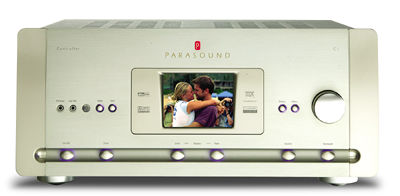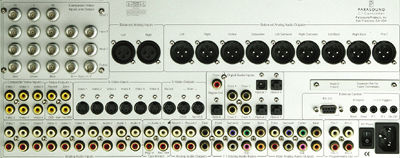Parasound Halo C1 Pre/Pro
While it may always get second billing in the parade of human emotions, don't forget about anticipation's potent influence. This is the force that has been linked to Parasound's Halo C1 pre/pro ever since its trade-show debut a few years back, and it has only gained momentum with each successive instance of display without delivery. While some critics speculated that Lucas-like patterns of prolonged hype were at work, most people figured that Parasound simply wanted the C1 to be right before they finally let it go. Once you dig into it, you'll see why that took some time.

History aside, the C1 is now here for real, and it looks like it was worth the wait. It would be a serious understatement to call this unit fully featured. It's loaded with conventional features and offers plenty of rare and unique tricks, as well. Three pages will hardly cover everything, but, trust me, you won't find much that this machine can't do. The Dolby, DTS, and THX processing contingents are fully represented, including Dolby EX and Pro Logic II, THX Ultra 2 Cinema and Music, and DTS ES and Neo:6. The C1 is also THX Ultra 2–certified. The highly regarded Flextronics DSP engine manages Motorola's 24-bit Symphony DSP56367 chip, which handles processing. Top-shelf internal components continue with Burr-Brown op amps for analog signals and 24-bit/96-kilohertz AKM codecs.
The C1's connections are expectedly ample. There are eight digital audio inputs (four coaxial, four optical) and two outputs, 10 analog stereo inputs, a tape loop, and three additional analog stereo outputs (one for zone 2). The eight-channel analog input offers a full-bypass feature (which Parasound doesn't offer for the unbalanced analog stereo inputs). Balanced connections (XLR) include nine outputs and an input pair (which is always a welcome but far-too-rare addition in the high end). There's also a full-bypass feature for the balanced inputs, in which only the analog volume control is enabled. For video, there are three component inputs that are specified as full-bandwidth (two are RGB-compatible with horizontal and vertical synchronization, which I haven't seen on any consumer pre/pro) and a component output (also with sync), all of which use BNC connectors. Parasound includes RCA-to-BNC adapters, but this should be a temporary solution. There are six composite and six S-video inputs, with three S-video outs and four composite outs (including one for zone 2). IR jacks and 12-volt triggers are aboard, as well. An expansion port allows for future hardware updates.
The two-way RS-232 port offers several possibilities. Naturally, this port allows for software updates and communication with a high-end control system. The port also allows you to link the C1 to your PC to use Parasound's excellently executed setup software, dubbed HaloControl. Unlike the few other PC-based setup programs I've used, HaloControl is purely optional; you can perform all of the same functions via the onscreen system (welcome news for the computerphobe). For the computerphile, HaloControl offers quick, user-friendly access that, like the OSD, gives you a serious amount of control over all of the C1's aspects, including major customization of individual sound modes and sources and a wide variety of save options for backing up your changes. I imagine that custom installers, in particular, will find HaloControl to be a highly beneficial and time-saving option.

Whichever system you use, setting up this complex, flexible component is relatively simple. A well-written manual and two quality remotes also help. The primary remote is a customized Home Theater Master MX-700, a display-screen/hard-button hybrid that's far easier to wield than a cheap touchscreen. The smaller SideKick remote allows for quick access to the C1's main functions.
You can find even more rare and unique C1 tricks on the front and back panels. The front-panel highlight is the 5-inch TFT screen that offers quick (but small) OSD access and can display any connected video source. Hell, it just looks cool, too. There's also a microphone input (and a mike in the box), which you can use for the latest version of the quality automatic speaker-level-and-distance calibration feature that Parasound has offered on their previous pre/pros. On the back panel, next to the main unbalanced outputs, are four additional output channels that hint at some unique possibilities. Two are dedicated to the lower frequencies: One parallels the main sub channel for multi-sub setups, and one has a low-pass filter fixed at 20 hertz for use with tactile transducers or other ultra-low-frequency applications. The remaining two channels are highly flexible: While they are derived from the main channels, you can use them for additional surround speakers, ceiling/height channels, stereo sub or rear sub applications, or just about anything else. You can customize these channels' output levels (adjusted in percentages), delays, high- and low-pass filters (adjustable in 5-Hz increments), and even polarity.
- Log in or register to post comments



































































